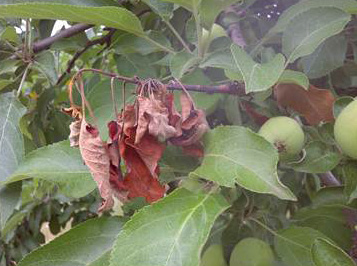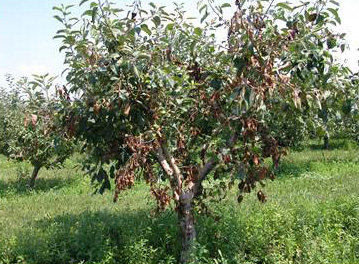Summer management of fire blight
Learn about managing fire blight during the summer in apple orchards.
This year has seen ideal conditions for fire blight, with the hot, humid weather during bloom leading to extreme infection periods, and the numerous storm events across the province since then. Fire blight symptoms are now present in many apple orchards (figure 1 and 2), including on less susceptible varieties and in orchards that have never had issues with the disease before.


Although many growers applied sprays at bloom based on predictive models (Cougar Blight or MaryBlyt), the extended and/or frequent infection periods may have left blossoms vulnerable to attack from bacteria. The symptoms of these early season infections may be just appearing now in orchards. However, fire blight can also enter trees through wounds caused by hail, insects, summer pruning, deer feeding, and even thunderstorms. In fact, inoculum can be spread large distances throughout a region during storms. So, the infections that are appearing in some areas may be a result of post-bloom infections.
It is important to remember that trees, particularly young trees, can be infected but not exhibit symptoms of the disease until ideal conditions occur the subsequent season. Once conditions are right, the bacteria move quickly from the new growth through to the older growth. Bearing and non-bearing young trees can be killed by this disease, while older mature trees may survive but show significant damage.
So, now that fire blight is present, to prune or not to prune-that is the question all growers are asking. Unfortunately there is no easy answer, since the severity of the infection and the weather conditions suitable for infection impact the decision.
Pruning the trees at this time of year can have two different outcomes:
- Reduce the inoculum and prevent the spread of disease.
- Increase shoot growth, making the tree even more susceptible to fire blight.
When dealing with older (>10 year old) vigorous trees that have many fire blight strikes, avoid pruning out shoot and blossom strikes early in the growing season. Extensive early pruning stimulates trees to produce succulent shoots, making them more susceptible to infections. When dealing with high vigour trees that have only a few fire blight infections, pruning out the fire blight may help to provide complete control of this disease.
In slow growing, low vigour trees or trees that have been sprayed with Apogee, the bacteria generally doesn't move into major limbs or trunks during the growing season. As a result, lesions can be pruned out when the tree is dormant. This may help to save growers time and money.
In comparison, young vigorous trees are very susceptible to fire blight and the bacteria may move rapidly into the trunk and down to the rootstock, killing the tree. As a result, pruning is recommended on young trees as soon as infection appears to prevent the spread of the disease to adjacent trees.
Keep in mind that once the terminal buds have set on apple trees, fire blight stops spreading within infected trees. Summer pruning to increase fruiting wood in high-density orchards encourages new shoot growth and extends the susceptibility period for shoot blight. However, leaving the disease in the orchard may serve as a source of inoculum, and cause increased infections in the result of hail, severe storm, or high wind damage.
If you decide to prune out fire blight strikes, remember to make cuts into at least 2 year old wood where the bacteria is less likely to multiply. Pruning cuts should be about 30 cm (12 inches or more) below the visible symptoms. Always prune during cooler, dry weather, since it reduces the potential for spreading the disease. Do not prune when day time temperatures are above 28°C. During pruning, tools should be disinfected between cuts by dipping them in a 70% to 75% denatured ethyl alcohol solution (one part denatured alcohol to three parts water) or a 6% sodium hypochlorite solution (one part laundry bleach to four parts water).
In sections where trees are severely affected or trees are continuously infected year after year, it may be more cost-effective to simply prune it than remove the whole tree.
Other important points to keep in mind:
- If applying copper, reduce the risk of phytotoxicity by using alone on dry leaves under fast-drying conditions with low volumes of water.
- If wet weather is not predicted, pruning clippings should be tossed into the row middles and allowed to dry before mowing them down.
- Avoid hand thinning, bud pinching and other activities until after terminal set, since these activities may help to spread the disease.
- Continue monitoring and managing insects in infected blocks that may spread the fire blight bacteria, such as aphids and leafhoppers.
There is an updated version of Maryblyt now available for Windows, which incorporates several cosmetic and functional changes. The update can be downloaded free of charge from the West Virginia University KTFREC website.
Take advantage this fall and winter to familiarize yourself with the program, so it's ready to be used when the time comes next year.